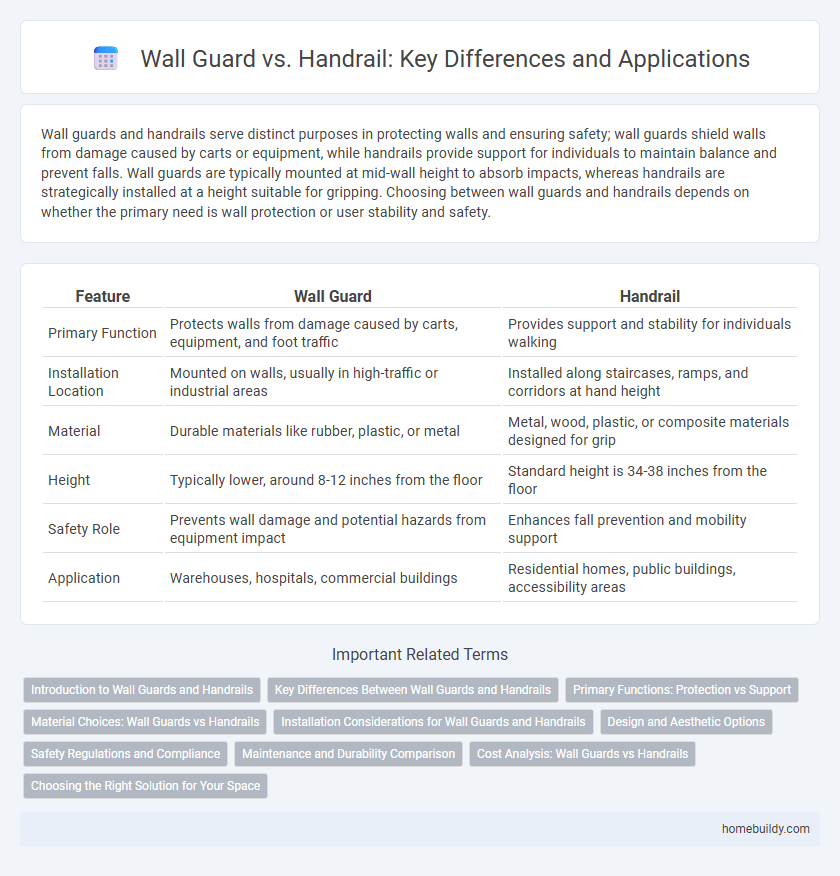Wall guards and handrails serve distinct purposes in protecting walls and ensuring safety; wall guards shield walls from damage caused by carts or equipment, while handrails provide support for individuals to maintain balance and prevent falls. Wall guards are typically mounted at mid-wall height to absorb impacts, whereas handrails are strategically installed at a height suitable for gripping. Choosing between wall guards and handrails depends on whether the primary need is wall protection or user stability and safety.
Table of Comparison
| Feature | Wall Guard | Handrail |
|---|---|---|
| Primary Function | Protects walls from damage caused by carts, equipment, and foot traffic | Provides support and stability for individuals walking |
| Installation Location | Mounted on walls, usually in high-traffic or industrial areas | Installed along staircases, ramps, and corridors at hand height |
| Material | Durable materials like rubber, plastic, or metal | Metal, wood, plastic, or composite materials designed for grip |
| Height | Typically lower, around 8-12 inches from the floor | Standard height is 34-38 inches from the floor |
| Safety Role | Prevents wall damage and potential hazards from equipment impact | Enhances fall prevention and mobility support |
| Application | Warehouses, hospitals, commercial buildings | Residential homes, public buildings, accessibility areas |
Introduction to Wall Guards and Handrails
Wall guards serve as protective barriers mounted on walls to prevent damage from carts, equipment, and foot traffic, while handrails primarily offer support and stability for individuals navigating stairs or ramps. Unlike handrails, wall guards focus on preserving wall surfaces in commercial and industrial environments by absorbing impact and abrasion. Both installations enhance building safety, with wall guards emphasizing structural protection and handrails prioritizing user assistance.
Key Differences Between Wall Guards and Handrails
Wall guards provide protection by absorbing or deflecting impact to prevent wall damage, while handrails offer support and stability for individuals navigating stairs or ramps. Wall guards are typically installed at a height that aligns with potential contact points from carts or equipment, whereas handrails are positioned within ergonomic reach for user grip. Material choices and design also differ, with wall guards focusing on durability and impact resistance and handrails emphasizing comfort and safety compliance.
Primary Functions: Protection vs Support
Wall guards provide essential protection by absorbing and deflecting impacts to prevent wall damage in high-traffic environments, while handrails primarily offer physical support and stability for individuals navigating stairs or ramps. The durability and positioning of wall guards are designed to shield walls from carts, equipment, and wheelchairs, enhancing safety and reducing maintenance costs. In contrast, handrails are ergonomically engineered to assist users with balance and mobility, promoting accessibility and injury prevention.
Material Choices: Wall Guards vs Handrails
Wall guards typically use high-impact materials such as vinyl, rubber, and stainless steel to provide durability and impact resistance in high-traffic areas. Handrails are often constructed from wood, aluminum, or wrought iron, focusing more on ergonomic grip and aesthetic appeal. Material selection for wall guards prioritizes protection and longevity, while handrails emphasize comfort and design integration.
Installation Considerations for Wall Guards and Handrails
Wall guards typically require mounting at mid-wall height, often between 32 to 36 inches from the floor, ensuring protection against impacts while complying with ADA guidelines. Handrails are installed at a higher elevation, generally 34 to 38 inches above the stair tread, providing support for users during ascent or descent. Installation of wall guards demands secure anchoring to wall studs or blocking to absorb force, whereas handrails necessitate robust brackets and precise alignment for ergonomic grip and safety.
Design and Aesthetic Options
Wall guards offer a wider range of design and aesthetic options compared to handrails, including customizable materials, colors, and finishes that seamlessly blend with interior decor. Unlike handrails, wall guards can be designed as continuous protective panels that provide both functionality and visual appeal, enhancing architectural elements without obstructing wall surfaces. Their sleek profiles and minimalistic styles make wall guards ideal for modern spaces seeking subtle yet effective wall protection.
Safety Regulations and Compliance
Wall guards provide enhanced protection against wall damage and improve safety in high-traffic areas by preventing injuries due to falls or collisions, meeting OSHA and ADA compliance standards. Handrails primarily offer support and stability on stairs, ensuring compliance with building codes specific to handrail height and strength requirements. Both systems must adhere to local safety regulations, with wall guards focusing on impact resistance and handrails on grip and load capacity for comprehensive safety.
Maintenance and Durability Comparison
Wall guards typically require less maintenance than handrails due to their robust construction and material resistance to impacts, scratches, and environmental factors. Handrails, often subjected to frequent handling, may experience faster wear and require regular cleaning and refinishing to maintain appearance and safety standards. The durability of wall guards makes them a cost-effective choice for high-traffic areas with minimal upkeep compared to handrails.
Cost Analysis: Wall Guards vs Handrails
Wall guards typically offer a more cost-effective solution than handrails due to lower material and installation expenses, especially in high-traffic commercial settings. Handrails generally require more robust anchoring and compliance with accessibility codes, increasing both initial costs and maintenance requirements. Evaluating long-term durability and repair frequency is essential for a comprehensive cost analysis between wall guards and handrails.
Choosing the Right Solution for Your Space
Wall guards provide robust protection against impact damage on walls in high-traffic areas, while handrails offer essential support and safety for stairways and ramps. Selecting between a wall guard and a handrail depends on specific needs such as preventing wall damage versus enhancing mobility and fall prevention. Assess the environment's function, traffic pattern, and safety regulations to determine the optimal solution that balances durability, accessibility, and compliance.
Wall guard vs Handrail Infographic

 homebuildy.com
homebuildy.com